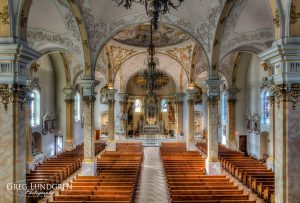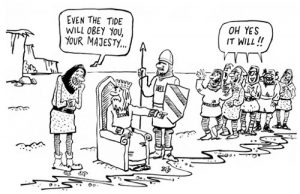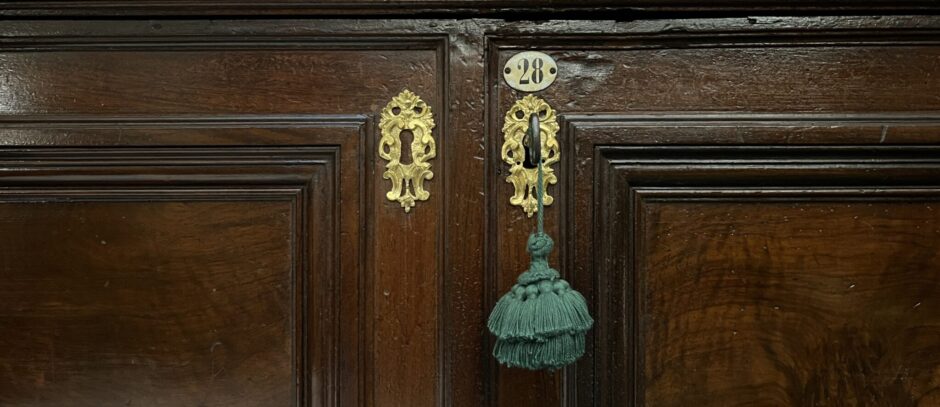 A young woman at my home parish, St. Agnes in St. Paul, MN, penned a piece for the National Catholic Register in reaction to Pope Francis’ recent curious statements about liturgical reform.
A young woman at my home parish, St. Agnes in St. Paul, MN, penned a piece for the National Catholic Register in reaction to Pope Francis’ recent curious statements about liturgical reform.
As you may recall, the Pope (or, better, his ghost writer) seemed to pour cold water (and gasoline, it turns out) on the desire of those for a so-called “reform of the reform” even as he seemed to be invoking the Magisterium in saying that forward progress cannot be reversed.
What makes one scratch one’s head is that what drives movements in the Church (such as that which drove the Liturgical Movement and which will, inexorably drive further developments in in our sacred liturgical worship) don’t seem to be the object of magisterial declarations.
To make an analogy, King Cnute the Great famously instructed his sycophant vassals, who greasily said that even the tide would obey him, that there were limits to what he could command. In their presence, Cnute ordered the tide not to come in. Of course the tide did come in. He told his fawning nobles, “How empty and worthless is the power of kings, for there is none worthy of the name other than He whom heaven, earth, and sea obey by eternal laws.” After that, the King hung his crown upon a crucifix and never wore it again.
Similarly, people can claim that all day that there is “no going back” when it comes to liturgical reform, but they simply can’t know that. We can strongly suspect that the impact of Vatican II (and many of the things wrought in the name of the Council) will never be reversed, but we can’t know that.
Popes don’t command the tide. Their enthusiastic and imprudent and papalatrous supporters, like the toadies who told Cnute that even the tide would obey him, have to learn this soon before they do harm to souls.
 Pope Benedict, in issuing his monumentally important Summorum Pontificum, ensured that there would be a dialogue of the two forms, traditional and post-Conciliar. There is now a channel for the forward flow. However, Benedict hoped for mutual enrichment of the forms. He issued his norms and then, at the end of the instructive letter to the world’s bishops that accompanied the Motu Proprio, entrusted those norms to the Blessed Virgin. Did you know that? Benedict entrusted his project to Mary.
Pope Benedict, in issuing his monumentally important Summorum Pontificum, ensured that there would be a dialogue of the two forms, traditional and post-Conciliar. There is now a channel for the forward flow. However, Benedict hoped for mutual enrichment of the forms. He issued his norms and then, at the end of the instructive letter to the world’s bishops that accompanied the Motu Proprio, entrusted those norms to the Blessed Virgin. Did you know that? Benedict entrusted his project to Mary.
Neither Benedict nor Francis command the tide any more than King Cnute. We can only channel it. That’s what Summorum Pontificum is: it’s like a channel. Channels guide the flow.
Of course it is possible to hack away at the banks channels to create chaos and destruction.
To use another simile, the Motu Proprio is like a gravitational force introduced to act on a body that is moving in its trajectory. Remember your physics? Bodies in motion tend to stay in motion unless another force works on them to change their course. So too, side by side celebrations of the traditional form with the Novus Ordo will exert a strong influence particularly on the Novus Ordo, since the traditional form has far more “gravitas“.
Will tradtional gravitas entirely turn around and reverse the course of the Novus Ordo? I doubt it. I can’t know one way or another. I am sure that the gravitas by which the traditional faithful conduct themselves will be a factor. But I digress.
As I have been saying on this blog for many years, the Novus Ordo is not going to go away any time soon. Moreover, we now see many fruits of Benedict’s bold and overdue move. That has spooked some people who are now flailing about trying to stop the tide, trying to spur Francis to command the tide that he cannot command.
Back to the piece that NCRegister. Here’s a short taste of the writer said (my emphases and comments):
[…]
[M]ost of the Catholic Church has been reeling ever since the introduction of the New Mass, and it seems to me that the waves from the rocks thrown into the water are settling down, and the things worth having are floating back to the surface. A lot of younger Catholics, raised since the 80s are fishing out of the water the beautiful things left to sink to the bottom. So, I say, let us not reverse what has been done, let us move forward. [I respond: “Forward” is the only gear that the tank has.]
The pope gave three keys in his speech to having a “living” liturgy. These were to have a focus on the lively presence of Him who ‘dying has destroyed our death, and by rising, restored our life,” to be not clerically focused but “an action for the people, but also by the people,” and to transform one’s life—it should bring us into relationship to God. The pope said that, “There’s a big difference between hearing that God exists, and feeling that he loves us, just as we are, here and now.” (quotations from Crux). [ALL of those things are possible and even carried out in a superior way in the older, traditional form of Mass, especially when celebrated ad orientem. Think about this: Would Catholics have gone to Mass or have tolerated he dearth of these elements for centuries? Of course not.]
These points Pope Francis made are important and can be fully practiced in the OF and the EF. It is not weak human beings that can make a “living” liturgy, but the action of the Holy Spirit—and by simply gathering in Christ’s name, he has promised to be there (Mt 18:20). Christ makes himself lively and present, we can call upon him to help us at whatever form of liturgy is celebrated. Even at the barest bones liturgy when the priest’s heart is not in it—if he says the right words of consecration, Christ is there. In my experience, each individual at Mass has to choose to focus on the lively presence of God—it cannot be forced. And more often than not a quiet, simple liturgy is much more conducive to prayer and worship than one interrupted by much chatter. Yet, no matter what the liturgy is like, it is up to each individual member of the faithful to enter fully into the Mass.
The pope said that the liturgy should be an action “for the people” and “by the people.” The practice of the priest leading us in prayer with us all facing the same way towards a crucifix (ad orientem), facing reverently Jesus’ Real Presence in the tabernacle, is much more suited to a mass “for the people” than one in which the priest speaks facing the laity (versus populum). [Exactly.] When done this way, the priest is no longer the center of attention. He does not have to “perform”, but can simply enter into the person of Christ that he is for the Church at that moment. He is able to allow the liturgy to no be about himself front and center at Mass, but face his Lord and act as Christ at the Last Supper for the people. The people at this time must actively participate by bringing our own internal offerings to the sacrifice—uniting our sufferings and joys and bringing sorrow for our sins which are the very cause of Christ’s death and resurrection. The liturgy should facilitate this internal participation to match the actions on the altar as we all worship Our Lord as a united body.
[…]
I see that, after all these years, the ars celebrandi so carefully fostered at St. Agnes is still bearing fruit.


































Father, I wonder if you have seen the recent, excellent article about the New Mass posted at OnePeterFive.
[Of course I did. I commented on it.] It absolutely horrified me.
It was a conference given by Archbishop Lefebvre on his eyewitness, first hand testimony on how Bugnini (a mere priest at the time, who had actually been dismissed by Pope John XXIII for his Modernism) single-handedly devised the New Mass without conferring with the Cardinals and without a Commission of any kind; and how he would bypass all his superiors to have Pope Paul VI sign off on changes to be made in the Mass! (This also correlates with the account of how Pope Paul VI wept when he discovered he had unknowingly given his signature to the elimination of the Octave for Pentecost).
[Which anecdote had its origins with me and my conversations with a former MC.]
It is from Bugnini (!) that we have received the New Mass, not from Tradition and not from Holy Mother Church by means of a valid Commission with a proper mandate to lay hands upon the Sacred Liturgy, thus ensuring its work would be life-giving not destructive, as we have seen.
Such treachery cannot possibly be blessed by God, nor can such villainy bear good fruit, only bad.
It is for this reason we have seen the New Mass produce only a sterility which has laid waste the previously fruitful and magnificent Vineyards of the traditional liturgy.
I don’t believe the New Mass – a villanous concoction from Protestant texts (as explained by Lefebvre) – will be allowed to stand.
I believe God will bring about a cataclysmic cleansing of the Church… if we are not in the last times… and restore the Liturgy to its former splendor, giving us once again a liturgy worthy of God Himself and a foretaste of Eternity.
After 40 Years of regularly attending the Traditional liturgies, I have been recently deprived of such a blessing for a number of reasons. Hence I must attend the New Mass both on a daily basis and on Sundays.
I cannot tell you what a banal, soul emptying experience this has been. I must struggle every day to resist the deleterious effects of regularly assisting at the New Mass without the antidote of the Traditional one.
On the few recent occasions when I have been able to experience the Traditional Mass once again, it is like being exposed to a fire hose of Grace that floods the soul, renews and purifies it, lifting it up to God. The contrast is profound and revealing.
No, the New Mass is the work of man, and a treacherous Modernist at that. God will not let it stand.
Archbishop Lefebvre saw firsthand the treachery which took place at the Second Vatican Council; and when seminarians came to him afterward lamenting the horrors they were experiencing in the Seminary after the Council, he responded to their entreaties by offering them the alternative which was always the Church’s: Tradition.
The treachery wrought within the bosom of Holy Mother Church will one day be revealed to our eyes, as it was seen first-hand by Archbishop Lefebvre. Then we will understand everything.
I’m 50 and in a way am the first post Vatican II generation. I dimly remember my home church before the 70’s make over. My Dad had in his top drawer an old St. Joseph’s missal and I always wondered why it “went away.”
Honestly, I wish Mass was quieter. I’m suffocated my fellowship and community: schools, work, neighborhood, civic organizations…Facebook! My most prayerful and intimate time with Christ is sadly not at Mass, but at 6 in the morning at the Hospital chapel where I work; just me, the Divine Office and the Tabernacle. Titivilus has plenty of work to go around!
Father Z: I reckoned you must have brought to our attention the article on 1 Peter 5 but did not take time to go back and verify.
Regarding the anecdote about the MC and the Octave of Pentecost, I had heard that some years back from another source. I am very pleased that you have been able to corroborate it directly with the MC involved, otherwise some could say it was hearsay.
Does not all this prove the New Mass was not a true work – and will – of the Church as almost everyone believes (and I myself once scrupled over)?
Rather, that it was a treacherous usurpation and destruction by a few men of the Church’s Sacred Liturgy and ought to be corrected as a matter of justice and grave duty before God, not considered “irreversible”, “to be continued”…?
I truly believe that if we do not effect this reversal ourselves with God’s help, God Himself surely will, no matter the cost….either by raising up a holy Pope who will act with courage and far-reaching rectitude to set right the many crimes committed against the Church in Her Sacred Liturgy and now even Her Deposit of Faith; or by a cleansing of apocalyptic proportions. And I think the latter is something we all feel in our bones is coming.
I love and appreciate the extraordinary form. I loved when in El Paso our Bishop invited the FSSP. I stopped going in Dallas after having to defend the Anglican Use and Novus Ordo (along with KoC issues) I guess I’ll try again.
Pingback: MONDAY CATHOLICA EDITION | Big Pulpit
Pingback: Another young person’s reaction to Pope Francis about liturgical reform | Catholic Torch
Thanks for covering this. Many of my Brother Knights have teenagers and college age sons and daughters. Quite a few have told me that there children prefer going to a regular Mass or a more traditional Mass than a so called “youth Mass” that attempts to entertain. Over the past 15 years, it seems like many of these “youth Masses” in my diocese and neighboring dioceses have either been toned down (i.e. kids no longer on the altar, more appropriate music, no applause, etc. – thank you good pastors) or eliminated (again, thank you good pastors).
The young people are seeking truth, not entertainment, not social hour, etc.